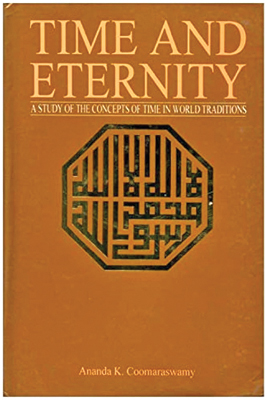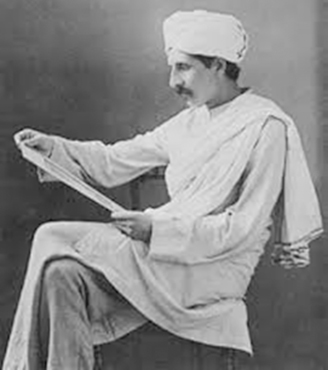Sri Lankan-born 20th-century polymath, Ananda Kentish Coomaraswamy has often been described as an art historian, aesthetic critic and professional geologist. Still, his impeccable contribution to unveiling oriental philosophies from the Vedas to the Upanishads and Buddhism with Christian mysticism is left aloof in Sri Lankan academia. Internationally Coomaraswamy’s fame is much accredited with his writings on metaphysics and perennial philosophy, which used to be Coomaraswamy’s major passion in his last few decades. Born to an English mother and a Ceylonese Tamil father, Coomaraswamy was exposed to a greater cultural diversity that other Victorians in the 19th Century lacked.
His eminent father Sir Muttu Coomarasawamy died when he was seven years and Coomaraswamy spent his childhood in England with his mother. The school he attended was different from the traditional Victorian public schools in England where students were given a classical type education however, the school that Coomaraswamy studied in England called Wycliffe school was known for its bohemian education and the vegetarianism was considered a policy of the school which may had influenced upon Ananda Coomaraswamy to live a vegetarian throughout his life.
Perennial philosophy
 One certain factor that we should understand in examining Coomaraswamy’s flare for mysticism and perennial philosophy is attributed to the intellectual transformation he underwent in his mid-50s because the writings he completed in his youth were mainly focused on Art history, Indian music and Iconography which brought him fame as a renowned art historian who was striving to create a bridge between the Oriental and Occidental cultures. After having carved a niche as an art historian, Coomaraswamy went on to study Metaphysics and Eastern religions compared with Christianity. His excellent knowledge of Greek, Latin, Sanskrit, Pali and many other languages made his learning quest easy.
One certain factor that we should understand in examining Coomaraswamy’s flare for mysticism and perennial philosophy is attributed to the intellectual transformation he underwent in his mid-50s because the writings he completed in his youth were mainly focused on Art history, Indian music and Iconography which brought him fame as a renowned art historian who was striving to create a bridge between the Oriental and Occidental cultures. After having carved a niche as an art historian, Coomaraswamy went on to study Metaphysics and Eastern religions compared with Christianity. His excellent knowledge of Greek, Latin, Sanskrit, Pali and many other languages made his learning quest easy.
His article published by an American scholarly journal in 1939 titled the ‘Vedanta and Western Tradition’ is an illustration of Coomaraswamy’s ability to comprehend Indian metaphysics and Western mysticism acutely. Regarding the universal nature of metaphysics, he states “The metaphysical ‘philosophy’ is called ‘perennial’ because of its eternity, universality and immutability; it is Augustine’s “Wisdom uncreated, the same now as it ever was and ever will be” the religion which, as he also says, only came to be called ‘Christianity’ after the coming of Christ”. His views on eternity or ‘Sanathana Dharma’ were nurtured by his affinity with the original texts of ancient mystics and religious philosophers such as Augustine, Orpheus and Sankara in depth. The Vedanta notion of ‘Oneness’ or ‘the highest spiritual reality’ was taken by Coomraswamy as a parallel notion to Christian mysticism and Western philosophy. As an example, he argued the platonic conception of the unification of inner and outer man and the Christian doctrine of membership in the mystical body of Christ as a resemblance to Vedanta philosophy.
Last years
The books written during Ananda Coomaraswamy’s last twenty years may be shorter in length compared to his earlier works on art criticism and oriental paintings but they are nonetheless insightful, showcasing his deep understanding of oriental religions and philosophies. For instance, ‘Time and Eternity’, though just 140 pages offers a vivid analysis of the concept of ‘time’ across major world religions.
In this book, he delves into the notions of time and eternity within Vedic, Buddhist, Greek and Christian contexts, demonstrating how each tradition perceives these concepts as metaphysical realities. His keen observations draw from major religious scriptures, displaying the depth of knowledge required to explore such complex ideas. Coomaraswamy’s relationship with the notorious English occultist Aleister Crowley further illustrates his intriguing life. While they were starkly different characters—Crowley being often criticised as a charlatan and seducer, while Coomaraswamy garnered respect for his scholarly contributions—both shared a flair for flamboyant attire that kept them at the centre of social circles. Their interaction began in 1917, when Coomaraswamy was married to Ratan Devi, a musician from Yorkshire.
Correspondence between Crowley and Ratan Devi suggested romantic feelings with Crowley even urging her to divorce Coomaraswamy at one point. Exploring the connections between Coomaraswamy and early 20th-century theosophists could yield interesting insights. The theosophists’ pursuit of the ultimate truth, or ‘ParamaVinshartha’, resonates with Coomaraswamy’s understanding of ultimate reality, which he compared to the Judeo-Christian concept of God the Father alongside Eastern religious teachings. An essential aspect of his work was his reliance on authentic sources to substantiate his analyses.
 For instance, his 1939 article ‘The Tantric Doctrine of Divine Beauty’ illustrates his profound comprehension of the Supreme Being where he articulately describes God as an “innumerable and perfectly simple Infinity,” embodying the duality of essence and non-being, or God and Godhead, likened to masculine and feminine principles.
For instance, his 1939 article ‘The Tantric Doctrine of Divine Beauty’ illustrates his profound comprehension of the Supreme Being where he articulately describes God as an “innumerable and perfectly simple Infinity,” embodying the duality of essence and non-being, or God and Godhead, likened to masculine and feminine principles.
Ananda Kentish Coomaraswamy dedicated many years to exploring how Christianity and Oriental philosophies understood art, making his insights particularly noteworthy. In his numerous writings and scholarly articles, he went beyond merely discussing the basic forms of art; he delved into the metaphysical realities that art can reveal. In his essay “Note on the Philosophy of Persian Art,” Coomaraswamy illustrates how Sufism or Islamic mysticism, is expressed in Persian iconography.
Intellectual transformation
During his final years as the curator of the Boston Art Museum, Coomaraswamy underwent a significant intellectual transformation, shifting his focus from art criticism to perennial philosophy. This transition left a lasting legacy in Western academia. Ironically, despite being born in Sri Lanka, his homeland has paid little attention to the extensive work he devoted half of his life to. While many Sri Lankan scholars consider ‘Medieval Sinhalese Art’ to be his greatest contribution, it is worth noting that this work was completed in his youth, before he reached the pinnacle of his scholarly maturity.
Undoubtedly, Coomaraswamy is one of the most influential figures in 20th-century aesthetic philosophy and a key proponent of Oriental mysticism in the West, although his true contributions have largely been overlooked by the country of his birth.
The writer is a lecturer at the Department of International Law, Faculty of Law, General Sir John Kotelawala Defence University






